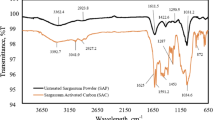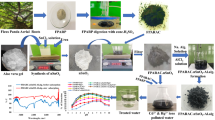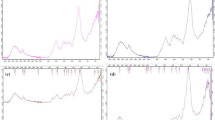Abstract
Heavy metal pollution has a harmful impact on human health and is regarded as a vital problem. Preparation of a novel, low cost bio-sorbent for heavy metal sorption is the main target of this research. Non-living Chlorella Vulgaris Alga/Date pit activated carbon composite (1:1), (CV/AC), is a novel bio-sorbent prepared by the wet-chemical method for sorption of Pb (II) and Sr (II) from aqueous media. The optimum pH for sorption reaction is 5 and the equilibrium time is achieved within 1 h. The sorption efficiencies are 90.5% for Pb(II) and 95.7% for Sr(II) with initial concentration Co 10 mg L–1 at 298 K. The monolayer sorption capacities of CV/AC composite at 298 K and pH = 5 were 6.34 ± 0.059, 5.97 ± 0.22 mg g–1. The saturation capacities were 98.5 and 125 mg g–1 for Pb (II) and Sr (II), respectively after 10 days. The sorption process is a spontaneous and endothermic reaction. It follows a pseudo-2nd-order mechanism. The results are suggestive of the need to adopt CV/AC composite as a potential bio-sorbent of Pb (II) and Sr (II) for waste water treatment.















Similar content being viewed by others
References
Meena AK, Mishra GK, Rai PK, Rajagopal C, Nagar PN (2005) Removal of heavy metal ions from aqueous solutions using carbon aerogel as an adsorbent. J Hazard Mater 122:161–170. https://doi.org/10.1016/j.jhazmat.2005.03.024
Malar S, Vikram SS, Favas PJC, Perumal V (2014) Lead heavy metal toxicity induced changes on growth and antioxidative enzymes level in water hyacinths [Eichhornia crassipes (Mart.)]. Bot Stud 55:1–11. https://doi.org/10.1186/s40529-014-0054-6
Nielsen SP (2004) The biological role of strontium. Bone 35(3):583–588. https://doi.org/10.1016/j.bone.2004.04.026
Chegrouche S, Mellah A, Barkat M (2009) Removal of strontium from aqueous solutions by adsorption onto activated carbon: kinetic and thermodynamic studies. Desalination 235:306–318. https://doi.org/10.1016/j.desal.2008.01.018
Argun ME, Dursun S, Ozdemir C, Karatas M (2007) Heavy metal adsorption by modified oak sawdust: thermodynamics and kinetics. J Hazard Mater 141(1):77–85. https://doi.org/10.1016/j.jhazmat.2006.06.095
Ali RM, Hamad HA, Hussein MM, Malash GF (2016) Potential of using green adsorbent of heavy metal removal from aqueous solutions: adsorption kinetics, isotherm, thermodynamic, mechanism and economic analysis. Ecol Eng 91:317–332. https://doi.org/10.1016/j.ecoleng.2016.03.015
Uddin MK (2017) A review on the adsorption of heavy metals by clay minerals, with special focus on the past decade. Chem Eng J 308:438–462. https://doi.org/10.1016/j.cej.2016.09.029
Ihsanullah AA, Al-Amer AM, Laoui T, Al-Marri MJ, Nasser MS, Khraisheh M, Atieh MA (2016) Heavy metal removal from aqueous solution by advanced carbon nanotubes: critical review of adsorption applications. Sep Purif Technol 157:141–161. https://doi.org/10.1016/j.seppur.2015.11.039
Demirbas A (2008) Heavy metal adsorption onto agro-based waste materials: a review. J Hazard Mater 157(2–3):220–229. https://doi.org/10.1016/j.jhazmat.2008.01.024
Inyang MI, Gao B, Yao Y, Xue Y, Zimmerman A, Mosa A, Pullammanappallil P, Ok YS, Cao X (2016) A review of biochar as a low-cost adsorbent for aqueous heavy metal removal. Crit Rev Environ Sci Technol 46(4):406–433. https://doi.org/10.1080/10643389.2015.1096880
Park HJ, Jeong SW, Yang JK, Kim BG, Lee SM (2007) Removal of heavy metals using waste eggshell. J Environ Sci 19(12):1436–1441. https://doi.org/10.1016/S1001-0742(07)60234-4
Kobya M, Demirbas E, Senturk E, Ince M (2005) Adsorption of heavy metal ions from aqueous solutions by activated carbon prepared from apricot stone. Bioresour Technol 96(13):1518–1521. https://doi.org/10.1016/j.biortech.2004.12.005
Matlock MM, Howerton BS, Atwood DA (2002) Chemical precipitation of heavy metals from acid mine drainage. Water Res 36(19):4757–4764. https://doi.org/10.1016/S0043-1354(02)00149-5
Fu F, Xie L, Tang B, Wang Q, Jiang S (2012) Application of a novel strategy-advanced fenton-chemical precipitation to the treatment of strong stability chelated heavy metal containing wastewater. Chem Eng J 189–190:283–287. https://doi.org/10.1016/j.cej.2012.02.073
Ma L, Wang Q, Islam SM, Liu Y, Ma S, Kanatzidis MG (2016) Highly selective and efficient removal of heavy metals by layered double hydroxide intercalated with the MoS42- ion. J Am Chem Soc 138:2858–2866. https://doi.org/10.1021/jacs.6b00110
Kurniawan TA, Chan GYS, Lo WH, Babel S (2006) Physico-chemical treatment techniques for wastewater laden with heavy metals. Chem Eng J 118(1–2):83–98. https://doi.org/10.1016/j.cej.2006.01.015
Meunier N, Drogui P, Montané C, Hausle R, Mercier G, Blais JF (2006) Comparison between electrocoagulation and chemical precipitation for metals removal from acidic soil leachate. J Hazard Mater 137(1):581–590. https://doi.org/10.1016/j.jhazmat.2006.02.050
Polat H, Erdogan D (2007) Heavy metal removal from waste waters by ion flotation. J Hazard Mater 148(1–2):267–273. https://doi.org/10.1016/j.jhazmat.2007.02.013
Zewail TM, Yousef NS (2015) Kinetic study of heavy metal ions removal by ion exchange in batch conical air spouted bed. Alex Eng J 54(1):83–90. https://doi.org/10.1016/j.aej.2014.11.008
Li Y, Xu Z, Liu S, Zhang J, Yang X (2017) Molecular simulation of reverse osmosis for heavy metal ions using functionalized nanoporous graphenes. Comp Mater Sci 139:65–74. https://doi.org/10.1016/j.commatsci.2017.07.032
Dakroury GA, Abo-Zahra ShF, Hassan HS (2020) Utilization of olive pomace in nano MgO modification for sorption of Ni(II) and Cu(II) metal ions from aqueous solutions. Arab J Chem 13(8):6510–6522. https://doi.org/10.1016/j.arabjc.2020.06.008
Mohan D, Pittman CU (2007) Arsenic removal from water/wastewater using adsorbents: a critical review. J Hazard Mater 42(1–2):1–53. https://doi.org/10.1016/j.jhazmat.2007.01.006
Dang SV, Kawasaki J, Abella LC, Auresenia J, Habaki H, Gaspillo PD, Kosuge H (2008) Removal of arsenic from synthetic groundwater by adsorption using the combination of laterite and iron-modified activated carbon. J Water Environ Technol 6(1):43–54. https://doi.org/10.2965/jwet.2008.43
Garg UK, Kaur MP, Garg VK, Sud D (2008) Removal of nickel(II) from aqueous solution by adsorption on agricultural waste biomass using a response surface methodological approach. Bioresour Technol 99(5):1325–1331. https://doi.org/10.1016/j.biortech.2007.02.011
Vieira MGA, Neto AFA, Gimenes ML, da Silva MGC (2010) Removal of nickel on Bofe bentonite calcined clay in porous bed. J Hazard Mater 176(1–3):109–118. https://doi.org/10.1016/j.jhazmat.2009.10.128
Sibi G (2019) Factors influencing heavy metal removal by microalgae—a review. J Crit Rev. https://doi.org/10.22159/jcr.2019v6i6.35600
Gupta VK, Rastogi A (2008) Biosorption of lead from aqueous solutions by green algae Spirogyra species: kinetics and equilibrium studies. J Hazard Mater 152(1):407–414. https://doi.org/10.1016/j.jhazmat.2007.07.028
Dakroury GA, Abo-Zahra ShF, Hassan HS, Ali HEA (2020) Improvement of the sorption behavior of aluminum silicate composite toward 134Cs and 60Co radionuclides by non-living biomass of Chlorella vulgaris. Environ Sci Pollut Res 27(17):21109–21125. https://doi.org/10.1007/s11356-020-08260-y
Jeyakumar RPS, Chandrasekaran V (2014) Adsorption of lead (II) ions by activated carbons prepared from marine green algae: equilibrium and kinetics studies. Int J Ind Chem 5:10. https://doi.org/10.1007/s40090-014-0010-z
El Nemr A, Shoaib AGM, El Sikaily A, Ragab S, Mohamed AA, Hassan AF (2021) Utilization of green alga ulva lactuca for sustainable production of meso–micro porous nano activated carbon for adsorption of Direct Red 23 dye from aquatic environment. Carbon Lett. https://doi.org/10.1007/s42823-021-00262-1
Han J, Lee K, Choi MS, Park HS, Kim W, Roh KC (2019) Chlorella-derived activated carbon with hierarchical pore structure for energy storage materials and adsorbents. Carbon Lett 29(2):167–175. https://doi.org/10.1007/s42823-019-00018-y
Bouchelt C, Medjram MS, Bertran O, Bellat JP (2008) Preparation and characterization of activated carbon from date stones by physical activation with steam. J Anal Appl Pyrolysis 82(1):70–77. https://doi.org/10.1016/j.jaap.2007.12.009
Jabar JM, Owokotomo IA, Ayinde YT, Alafabusuyi AM, Oladunju GO, Mobolaji VO (2021) Characterization of prepared eco-friendly biochar from almond (Terminalia catappa L.) leaf for sequestration of bromophenol blue (BPB) from aqueous solution. Carbon Lett. https://doi.org/10.1007/s42823-020-00214-1
Krishnamoorthy R, Govindan B, Banat F, Sagadevan V, Purushothaman M, Show PL (2019) Date pits activated carbon for divalent lead ions removal. J Biosci Bioeng 128(1):88–97. https://doi.org/10.1016/j.jbiosc.2018.12.011
Al-Balushi K (2016) Optimisation of activated carbon from date seeds by physical and chemical methods—review
Lin J, Wang L (2009) Comparison between linear and non-linear forms of pseudo-first-order and pseudo-second-order adsorption kinetic models for the removal of methylene blue by activated carbon. Front Environ Sci Eng China 3:320–324. https://doi.org/10.1007/s11783-009-0030-7
Boyd GE, Adamson AW, Myers LS (1947) The exchange adsorption of ions from aqueous solutions by organic zeolites. II. Kinetics. J Am Chem Soc 69(11):2836–2848. https://doi.org/10.1021/ja01203a066
Weber WJ, Morris JC (1963) Kinetics of adsorption on carbon from solution. J Sanit Eng Div Am Soc Civ Eng 89(2):31–60
Dakroury GA, Abo-Zahra ShF (2020) The use of titanium oxide/polyethylene glycol nanocomposite in sorption of 134Cs and 60Co radionuclides from aqueous solutions. J Radioanal Nucl Chem 324:1351–1364. https://doi.org/10.1007/s10967-020-07167-9
Nikitas P (1984) Generalized Flory-Huggins isotherms for adsorption from solution. J Chem Soc Faraday Trans 80(12):3315–3329. https://doi.org/10.1039/F19848003315
Foo KY, Hameed BH (2010) Review: insights into the modeling of adsorption isotherm systems. Chem Eng J 156(1):2–10. https://doi.org/10.1016/j.cej.2009.09.013
Duygu DY, Udoh AU, Ozer TB, Akbulut A, Erkaya IA, Yildi K, Guler D (2012) Fourier transform infrared (FTIR) spectroscopy for identification of chlorella vulgaris beijerinck 1890 and scenedesmus obliquus (turpin) kützing 1833. Afr J Biotechnol 11(16):3817–3824. https://doi.org/10.5897/AJB11.1863
Alves A, Caridade SG, Mano JF, Sousa RA, Reis RL (2010) Extraction and physico–chemical characterization of a versatile biodegradable polysaccharide obtained from green algae. Carbohydr Res 345:2194–2200. https://doi.org/10.1016/j.carres.2010.07.039
Omri A, Benzina M (2012) Characterization of activated carbon prepared from a new raw lignocellulosic material: Ziziphus Spina-Christiseeds. J de la Soc Chim de Tunisie 14:175–183
Oliveiraa GED, Andradeb RCD, Trindadea MAG, Andradeb HMC, Carvalhoa CTD (2017) Thermogravimetric and spectroscopic study (TG–DTA/FT–IR) of activated carbon from the renewable biomass source Babassu. Quím Nova 40(3):284–292. https://doi.org/10.21577/0100-4042.20160191
Kumar PS, Korving L, Keesman KJ, Loosdrecht MCMV, Witkamp GJ (2019) Effect of pore size distribution and particle size of porous metal oxides on phosphate adsorption capacity and kinetics. Chem Eng J 358:160–169. https://doi.org/10.1016/j.cej.2018.09.202
Kurniawan TA, Chan GYS, Lo WH, Babel S (2006) Comparisons of low-cost adsorbents for treating wastewaters laden with heavy metals. Sci Total Environ 366:409–426. https://doi.org/10.1016/j.scitotenv.2005.10.001
Puigdomenech I (2013) Make equilibrium diagrams using sophisticated algorithms (MEDUSA), Inorganic Chemistry. Royal Institute of Technology, Stockholm Sweden. https://www.kemi.kth.se/medusa, https://sites.google.com/site/chemdiagr
Janusz W, Skwarek E (2016) Study of sorption processes of strontium on the synthetic hydroxyapatite. Adsorption 22:697–706. https://doi.org/10.1007/s10450-016-9761-5
Ramesh ST, Rameshbabu N, Gandhimathi R, Kumar MS, Nidheesh PV (2013) Adsorptive removal of Pb(II) from aqueous solution using nano-sized hydroxyapatite. Appl Water Sci 3:105–113. https://doi.org/10.1007/s13201-012-0064-z
Es-said A, Nafai H, Hamdaoui ELL, Bouhaouss A, Bchitou R (2020) Adsorptivity and selectivity of heavy metals Cd (II), Cu (II) and Zn (II) toward phosphogypsum. Desalin water treat 197:291–299. https://doi.org/10.5004/dwt.2020.25964
Yin Y, Wang J, Yang X, Li W (2017) Removal of strontium ions by immobilized saccharomyces cerevisiae in magnetic chitosan microspheres. Nucl Eng Technol 49(1):172–177. https://doi.org/10.1016/j.net.2016.09.002
Mittal A, Mittal J, Malviya A, Gupta VK (2010) Removal and recovery of Chrysoidine Y from aqueous solutions by waste materials. J Colloid Interface Sci 344(2):497–507. https://doi.org/10.1016/j.jcis.2010.01.007
Tafakori V, Zadmard R, Tabandeh F, Amoozegar MA, Ahmadian G (2017) Equilibrium isotherm, kinetic modeling, optimization, and characterization studies of cadmium adsorption by surface-engineered escherichia coli. Iran Biomed J 21:380–391
Latour RA (2014) The langmuir isotherm: a commonly applied but misleading approach for the analysis of protein adsorption behavior. J Biomed Mater Res A 103(3):949–958. https://doi.org/10.1002/jbm.a.35235
Ahmadi SJ, Akbari N, Shiri-Yekta Z, Mashhadizadeh MH, Hosseinpour M (2015) Removal of strontium ions from nuclear waste using synthesized MnO2–ZrO2 nano-composite by hydrothermal method in supercritical condition. Korean J Chem Eng 32:478–485. https://doi.org/10.1007/s11814-014-0249-2
Kamal ML, Tajam J, Hasan S, Ismai MHS, Naspu ASM, Zahala NSA (2014) A performance of hybrid biosorbent ‘M Bios’ of Pb (II) and Cu (II) in aqueous solutions. IJSRP 4(7):1–8
Ghaemi A, Mostaedi MT, Maragheh MG (2011) Characterizations of strontium(II) and barium(II) adsorption from aqueous solutions using dolomite powder. J Hazard Mater 190(1–3):916–921. https://doi.org/10.1016/j.jhazmat.2011.04.006
Smičiklas I, Dimovic S, Plecaš I (2007) Removal of Cs+, Sr2+ and Co2+ from aqueous solutions by adsorption on natural clinoptilolite. Appl Clay Sci 35:139–144. https://doi.org/10.1016/j.clay.2006.08.004
Anwar J, Shafique U, Zaman WU, Salman M, Dar A, Anwar S (2010) Removal of Pb (II) and Cd (II) from water by adsorption on peels of banana. Bioresour Technol 101(6):1752–1755. https://doi.org/10.1016/j.biortech.2009.10.021
Yavari R, Huang YD, Mostofizadeha A (2010) Sorption of strontium ions from aqueous solutions by oxidized multiwall carbon nanotubes. J Radioanal Nucl Chem 285(3):703–710. https://doi.org/10.1007/s10967-010-0600-y
Gupta VK, Ali I (2004) Removal of lead and chromium from wastewater using bagasse fly ash—a sugar industry waste. J Colloid Interface Sci 271(2):321–328. https://doi.org/10.1016/j.jcis.2003.11.007
Zuo R, Meng L, Guan X, Wang J, Yang Y, Lin Y (2019) Removal of strontium from aqueous solutions by acrylamide-modified attapulgite. J Radioanal Nucl Chem 319:1207–1217. https://doi.org/10.1007/s10967-019-06414-y
Jnr MH, Spiff AI (2004) Studies on the effect of pH on the sorption of Pb2+ and Cd2+ ions from aqueous solutions by Caladium bicolor (Wild Cocoyam) biomass. Electron J Biotechnol 7(3):14–15. https://doi.org/10.4067/S0717-34582004000300014
Acknowledgements
Authors are thankful to Dr. Hamdy Elsayed Ahmed Ali, Department of Radiation Microbiology, National Centre for Radiation Research and Technology (NCRRT), Egyptian Atomic Energy Authority, and Cairo, Egypt for his effort in cultural of Chlorella Vulgaris alga.
Funding
The authors received no financial support for the research, authorship, and/or publication of this article.
Author information
Authors and Affiliations
Contributions
GD, EES and HH contributed to the study conception and design, material preparation, data collection and analysis. All authors read and approved the final manuscript.
Corresponding author
Ethics declarations
Conflict of interest
The authors declare that they have no conflict of interest.
Ethical approval
The authors confirm that the manuscript has been read and approved by all authors. The authors declare that this manuscript has not been published and not under consideration for publication elsewhere.
Consent to participate
All of the authors consented to participate in the drafting of this manuscript.
Consent for publication
All of the authors consent to publish this manuscript.
Availability of data and materials
All the data used for this work are publicly available.
Research involving human participants and/or animals
Not applicable.
Additional information
Publisher's Note
Springer Nature remains neutral with regard to jurisdictional claims in published maps and institutional affiliations.
Rights and permissions
About this article
Cite this article
Dakroury, G.A., El-Shazly, E.A.A. & Hassan, H.S. Sorption of lead (II) and strontium (II) ions from aqueous solutions onto non-living Chlorella Vulgaris Alga/ Date pit activated carbon composite. Carbon Lett. 32, 495–512 (2022). https://doi.org/10.1007/s42823-021-00280-z
Received:
Revised:
Accepted:
Published:
Issue Date:
DOI: https://doi.org/10.1007/s42823-021-00280-z




